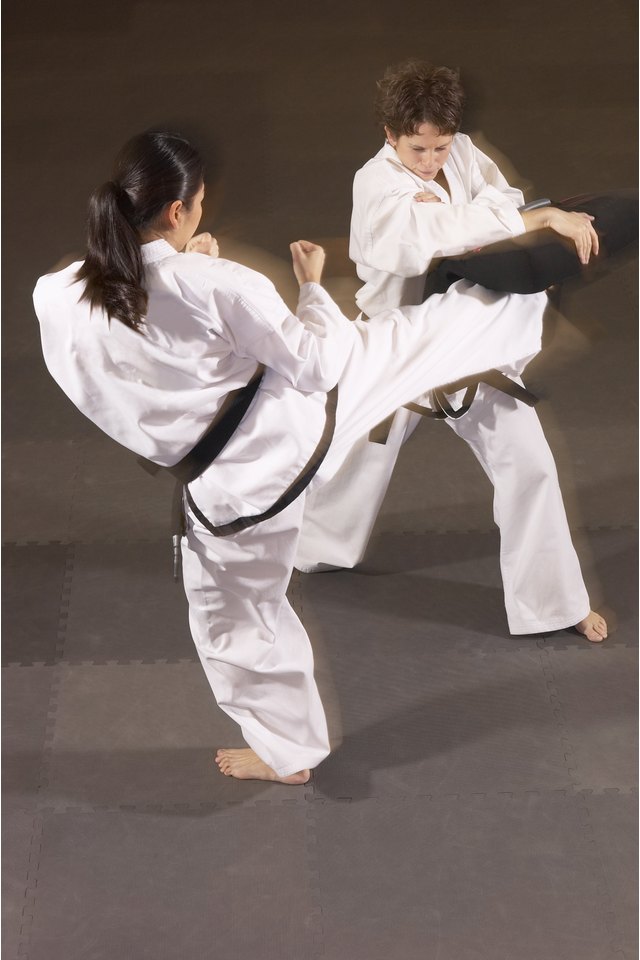Strengths & Weaknesses of Tae Kwon Do

Tae kwon do is a martial art that originated in Korea, but it has gained popularity all around the world. This art’s exciting fighting techniques led to it becoming an official Olympic medal sport in 2000. Tae kwon do’s dynamic aerial kicks seem almost superhuman. Like all fighting styles, however, this system has both strengths and weaknesses. In tae kwon do, if your strengths are truly effective, then an opponent won’t have a chance to learn about your weaknesses.
Kicking
Tae kwon do means “the way of kicking and punching,” but kicking is this fighting style’s main strength and what makes it stand out from other martial arts. In tae kwon do classes, you learn how to do a variety of fast and powerful kicks. These kicks can break boards or knock out adversaries. The most popular kick in this martial art is the roundhouse. This technique is delivered in a horizontal motion with the top or ball of the foot. The roundhouse kick typically hits an opponent’s midsection or head. Tae kwon do students spend a lot of time stretching so that they are able to kick to the head with ease. Many of tae kwon do’s kicks are performed with quick jumps and spins. Martial artists from other styles often find it difficult to block the deceptive kicking techniques of tae kwon do.
Footwork
Tae kwon do students frequently practice footwork drills. This fast, often tricky, footwork is another of tae kwon do’s strengths. Footwork is used to quickly advance on your opponent or retreat from him. It is also used to evade attacks. Well-developed footwork can help you evade an opponent’s attack and swiftly deliver your own counterattack. The slightest movement with your feet also helps you see how your opponent will react to your attacks. In addition, footwork can be used for feinting to trick your opponent into leaving himself open and vulnerable. In “Taekwondo Kyorugi: Olympic Style Sparring,” Sang H. Kim writes that “the key to feinting is to deceive an opponent psychologically and cause him to misjudge the situation.” Quick-footed tae kwon do students can literally stay one step ahead of other martial artists who are not as skilled on their feet.
Endurance
A tae kwon do class will challenge your cardiorespiratory and muscular endurance. Students consistently kick pads, perform footwork drills and spar each other. They also perform squats, lunges, pushups and other muscle-strengthening exercises. A tae kwon do practitioner’s endurance will help her outlast other opponents in a long fight. Some other fighting styles do not emphasize the importance of cardiorespiratory preparedness.
Close-Range Fighting
If you enroll in a tae kwon do class, you will learn how to punch and perform various strikes, but much more time is spent on the refinement of kicking skills. Tae kwon do practitioners, therefore, are typically weaker on their punches, elbows and other close-range skills. Other fighting styles, such as boxing and Wing Chun, focus more on dealing with close-range combat. If you can stop an opponent with a well-placed kick, however, you don’t have to worry about close-range fighting.
Ground Fighting
Tae kwon do is a stand-up fighting style. Practitioners typically spend little time performing ground-fighting techniques. If you’re a tae kwon do fighter, your goal is to keep an altercation off the ground so that you can use your arsenal of kicks. Going to the ground nullifies your main weapons. Against an experienced grappler, you would likely be at a serious disadvantage. Students of arts such as Brazilian jujitsu and judo spend most of their time rolling around on mats. They continually practice various locks and chokes while on the floor. With the recent popularity of mixed martial arts, some tae kwon do schools have added ground-fighting lessons to their curriculums.
References
- Olympic.org: Taekwondo Equipment and History
- Taekwondo-information.org: Start to Master Your Taekwondo Roundhouse Kick Here!
- WTF World Taekwondo Federation: What Is Taekwondo?
- Taekwondo Kyorugi: Olympic Style Sparring; Sang H. Kim
Writer Bio
This article was written by the CareerTrend team, copy edited and fact checked through a multi-point auditing system, in efforts to ensure our readers only receive the best information. To submit your questions or ideas, or to simply learn more about CareerTrend, contact us [here](http://careertrend.com/about-us).
